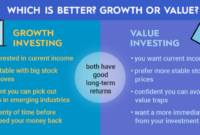Best Value Stock Opportunities – The world of value investing opens up countless possibilities for those who know how to uncover the hidden potential in undervalued stocks. Best value stock opportunities provide the chance to secure long-term gains by investing in companies trading below their intrinsic value. This guide explores key concepts, strategies, and actionable insights to help you master value investing. We’ll also discuss how to evaluate market trends, company fundamentals, and valuation techniques, so you can make informed investment decisions.
Table of Contents
ToggleUnderstanding Value Stocks: What Makes Them a Good Investment?
Value stocks are companies that trade at a lower price relative to their intrinsic worth. These stocks often have strong fundamentals, like consistent earnings, low debt, and a reliable competitive edge. Unlike growth stocks, which focus on future earnings, value stocks are typically stable companies that may be temporarily undervalued due to market conditions.
Key Characteristics of Value Stocks
Identifying value stocks involves understanding some key financial metrics:
- Price-to-Earnings (P/E) Ratio: This ratio compares a company’s stock price to its earnings per share. A lower P/E ratio may indicate an undervalued stock.
- Price-to-Book (P/B) Ratio: This ratio compares the stock price to the book value of the company’s assets, providing a sense of whether a stock is under- or overvalued.
- Dividend Yield: Companies that consistently pay dividends often indicate strong financial health. A high dividend yield might suggest a stock is undervalued.
- Strong Cash Flow: A positive cash flow can show a company’s ability to pay off debts and reinvest in its operations.
Value stocks are appealing because they provide a balance of low risk and steady income, making them attractive to conservative investors. However, the key to success lies in choosing the right stocks at the right time.
Market Analysis: Identifying Best Value Stock Opportunities
The market constantly shifts between periods of growth and contraction, affecting which stocks are considered undervalued. Understanding the current market environment is crucial for identifying the best value stock opportunities.
Market Trends and Indicators to Watch
When searching for value stocks, it’s important to:
- Track Market Cycles: Recognize whether the market is in a bull or bear phase. In bull markets, value stocks may be overshadowed by growth stocks. In bear markets, value stocks often gain traction.
- Identify Undervalued Sectors: Some sectors, like energy or healthcare, may be undervalued due to cyclical downturns or economic changes. Look for industries poised for recovery or long-term growth.
- Monitor Economic Indicators: Pay attention to factors like interest rates, inflation, and GDP growth, which can influence the overall economy and specific sectors.
Table: Key Economic Indicators Impacting Value Stocks
| Indicator | Description | Impact on Value Stocks |
|---|---|---|
| Interest Rates | Cost of borrowing money | Higher rates may depress stock prices |
| Inflation | Increase in prices of goods and services | High inflation can impact profit margins |
| GDP Growth | Economic expansion or contraction | Strong GDP growth supports value stocks |
| Unemployment Rate | Percentage of the workforce without jobs | Lower unemployment can boost spending |
These indicators help investors forecast which sectors may outperform and where best value stock opportunities may lie.
Company Fundamentals: The Heart of Value Investing
A company’s financial health is at the core of identifying good value stocks. Analyzing fundamentals helps distinguish between a truly undervalued company and one that is just cheap for a reason.
Evaluating Key Company Metrics
When assessing a company’s fundamentals, consider:
- Revenue Growth: Look for companies with stable or increasing revenues, as this indicates a solid business model.
- Profit Margins: High profit margins suggest efficient operations. Compare a company’s margins with industry averages to determine if it’s a true value stock.
- Debt Levels: A low debt-to-equity ratio is usually a positive sign, showing the company isn’t over-leveraged.
- Management Quality: Good leadership often leads to strong financial performance. Research a company’s executive team and board of directors for insights.
Checklist: Key Metrics for Evaluating Company Fundamentals
| Metric | Description | What to Look For |
|---|---|---|
| Revenue Growth | Annual increase in total revenue | Consistent growth |
| Profit Margins | Net income as a percentage of revenue | Above industry average |
| Debt-to-Equity Ratio | Measure of financial leverage | Lower than industry average |
| Cash Flow | Net cash generated by the business | Positive and growing |
These fundamentals provide a comprehensive view of a company’s financial health and help in making an informed investment decision.
Valuation Techniques: Assessing Intrinsic Value
Determining whether a stock is truly undervalued requires various valuation techniques. This section will guide you through some of the most common methods used to assess best value stock opportunities.
Popular Valuation Techniques
- Discounted Cash Flow (DCF) Analysis: This method involves forecasting the company’s future cash flows and then discounting them back to their present value. It’s a detailed approach but can provide accurate results if done correctly.
- Comparable Company Analysis: By comparing a company’s financials to similar companies in the same industry, investors can determine if it’s undervalued. This method works well for identifying industry-specific value stocks.
- Asset-Based Valuation: This technique values a company based on its tangible and intangible assets. Subtracting liabilities from the asset value gives an estimate of what the company is worth.
Table: Pros and Cons of Valuation Techniques
| Valuation Method | Pros | Cons |
|---|---|---|
| Discounted Cash Flow (DCF) | Provides accurate intrinsic value if projections are correct | Requires precise forecasting; time-consuming |
| Comparable Company Analysis | Easy to use; good for sector-specific analysis | Relies on accurate peer comparison |
| Asset-Based Valuation | Suitable for companies with tangible assets | May overlook intangible factors like brand value |
By employing a combination of these techniques, investors can more accurately determine whether a stock is a good value investment.
Risk Management: Mitigating Investment Risks
Investing always carries risks, and value investing is no exception. To protect your portfolio from potential pitfalls, it’s essential to implement risk management strategies.
Effective Risk Management Techniques
- Diversify Your Portfolio: Avoid putting all your capital into a single stock or sector. Spread investments across different industries to reduce risk.
- Use Stop-Loss Orders: Automatically sell a stock if it drops to a predetermined price to limit potential losses.
- Evaluate Risk Tolerance: Understand your risk appetite and choose investments accordingly. Value stocks are generally less volatile, making them suitable for conservative investors.
- Stay Informed: Regularly monitor your investments and adjust your strategy based on market conditions.
Case Studies: Success Stories in Value Investing
To illustrate the power of value investing, let’s explore some notable success stories:
Warren Buffett and Berkshire Hathaway
Warren Buffett’s acquisition of Berkshire Hathaway in 1965 is a classic example of value investing. He purchased the company for $11.50 per share when it was considered a struggling textile firm. Over the decades, he transformed it into a diversified conglomerate worth over $400,000 per share.
Peter Lynch’s Fidelity Magellan Fund
Peter Lynch managed the Fidelity Magellan Fund from 1977 to 1990, achieving an average annual return of 29%. His strategy focused on investing in undervalued companies with strong fundamentals, emphasizing the importance of detailed analysis.
These case studies highlight that investing in value stocks can lead to exceptional returns if done carefully and strategically.
Conclusion: Making the Most of Best Value Stock Opportunities
Navigating the world of value investing requires a deep understanding of market trends, company fundamentals, and valuation methods. By mastering these components, investors can identify the best value stock opportunities and potentially enjoy substantial returns.
For those interested in value investing, it’s beneficial to explore additional resources like the Wikipedia Value Investing Guide to deepen your knowledge.
Investing in value stocks isn’t a guaranteed path to success, but with careful analysis, patience, and a disciplined approach, it’s possible to achieve significant financial gains. Remember, the journey involves continuous learning and adapting to ever-changing market dynamics.




